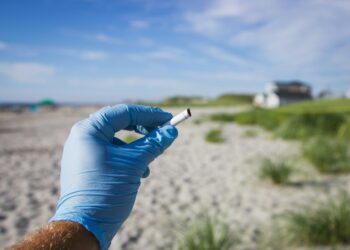
Shady sellers, shady products
The US was rocked by what seemed to be a vaping epidemic. Vaping-related lung injuries have killed at least 39 people and sickened more than 2,000 others.
The CDC signalled the dangers that e-cigarettes pose — devices that allow you to inhale nicotine in a vapour rather than smoke. But right from the start, something was weird about this situation.
For starters, the problems only seemed limited to the US. No other country reported similar trends; vaping was actually recommended as a way to reduce the negative impact of smoking (and as a stepping stone to quitting completely).
“E-cigarettes aren’t completely risk free but they carry a small fraction of the risk of cigarettes,” wrote the British National Health Service (NHS).
Vaping has been around for more than a decade, with tens of millions of users already — and nothing of this sort has ever been reported previously. It seemed that this was not a generalized problem, but to be on the safe side, the CDC advised everyone to not use any e-cigarette, or vaping products.
Now, after a thorough investigation, CDC officials believe they’ve found the culprit: Vitamin E.
“For the first time, we have detected a potential toxin of concern, vitamin E acetate, from biological samples from patients,” said Dr. Anne Schuchat, principal deputy director of the CDC. “These new findings are significant,” Schuchat added. “We have a strong culprit.”
Vitamin E is safe to ingest as a vitamin pill or as a lotion, but inhaling it can be harmful. However, because it is so cheap and available, it is often used on the black market of vape cartridge as a thickener in vaping fluid — which was killing and injuring consumers, the CDC believes.
The substance was detected in all 29 lung samples that the CDC analyzed, suggesting a strong correlation. While causation has not yet been proven, the link seems convincing. Nevertheless, Schuchet added that “many substances are still under investigation”.
The main takeaway is that you should never ever buy counterfeit or otherwise illegal e-cigarettes. You should steer clear of shady online or unregulated sellers, and only buy from licensed dispensaries. However, Schuchat warns users that it’s too soon to say whether it’s safe to use products even from licensed dispensaries. Which opens up a different side of the problem.
Has the CDC’s approach caused more harm than good?
According to a Reuters poll, 63% of adults disagree with the statement that “vaping is healthier than traditional cigarettes.” That is up 16 percentage points from a similar Reuters/Ipsos poll that ran in the spring of 2016. In addition, a mere 29% of adults think vaping is a good way to help people quit smoking. This is in strong contrast to what other researchers and health have been saying.
An NHS report found that e-cigs are 95% less harmful than regular cigarettes. E-cigarettes are most definitely not a good thing, and vaping is not a healthy habit — but the general position seems to be that when done properly, it is the lesser of two evils.
The CDC’s communication has led to a decline in vaping sales and, conversely, an increase in the sales of regular cigarettes. This could transform into a dangerous trend with long-lasting consequences.
Michael Siegel, an American tobacco control expert and public health researcher was very critical of the CDC’s approach.
In addition, as several governors rush to ban the same of e-cigs, this will only fuel the ‘bootleg’ production of e-cigs, which are the biggest danger in the first place.
This position was echoed by Dr. Mark Tyndall, Professor of Medicine at the University of British Columbia’s School of Population and Public Health
The investigation is still ongoing.






